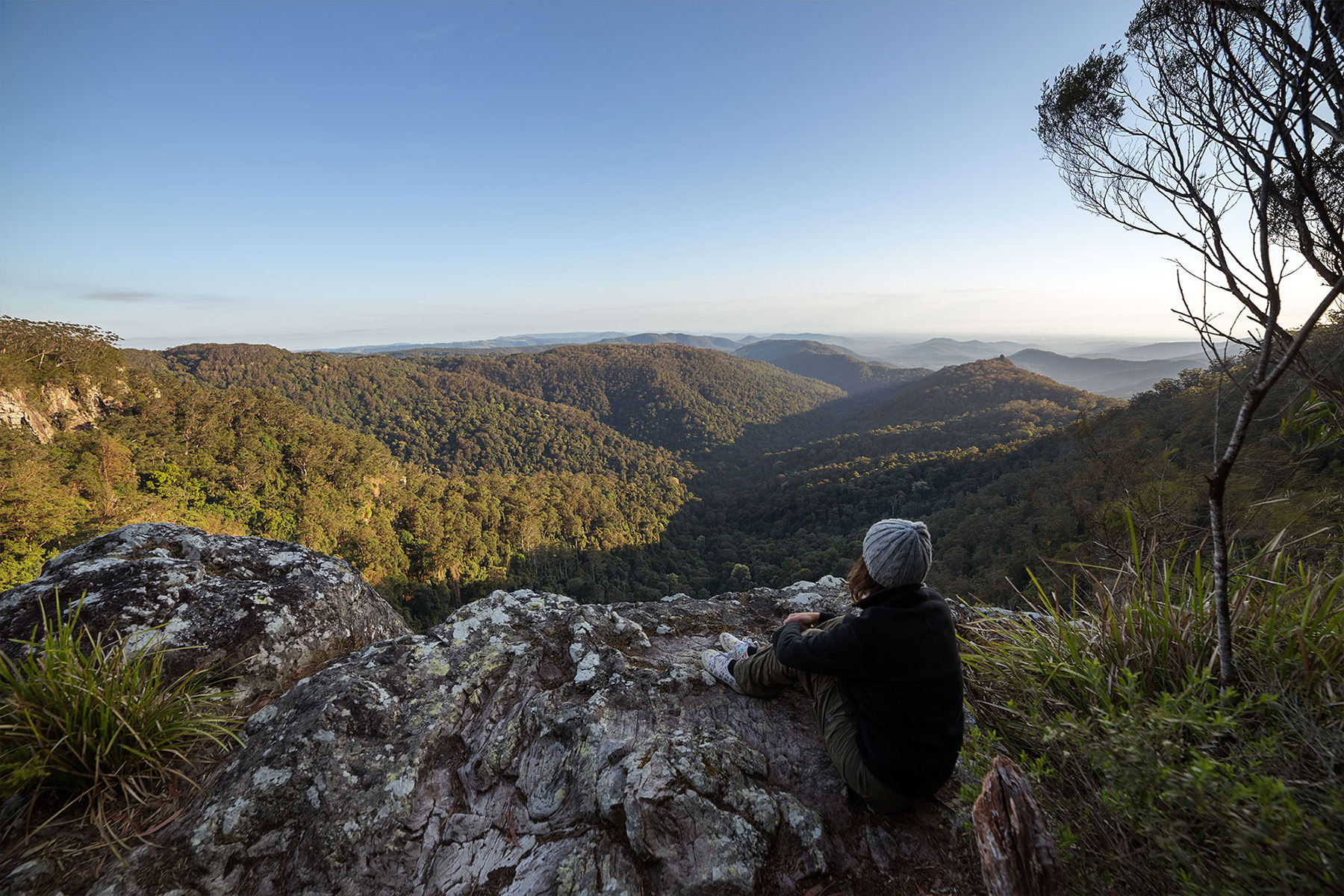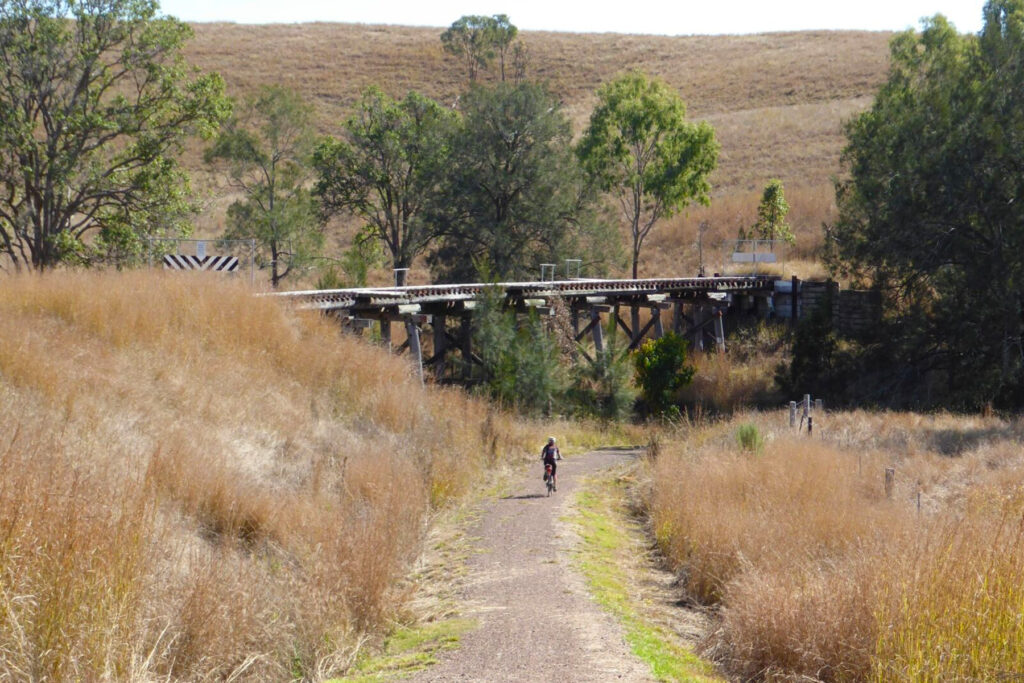
Lisa Frost
Trail Development
Active Trails
Active Trails
A Strategy for Regional Trails in South East Queensland
Recreation trails range from urban bicycle paths to canoe trails on rivers to rugged hinterland trails which, when combined, can provide for activities including walking, horse riding, cycling, driving, canoeing/kayaking and trail bike riding. Use of recreation trails by residents and visitors has quantifiable benefits in physical and psychological health, social and environmental terms. Research from Australia and overseas shows significant tourism and economic benefits derived from recreation on trails. These benefits include expenditure in rural and regional areas, return visits and increased overnight stays by domestic and international tourists.
The Draft South East Queensland Active Trails Implementation Guidelines were developed to assist local governments, trail planners and community groups to plan and develop a network of regional, district and local trails.
Contents
- Introduction
- Background
- Trail planning
- Trail design and construction considerations
- Trail management and maintenance
Ben Blanche
Australian Walking Track Grading System
The AWTGS classifies tracks into 5 grades, based on the Australian Standard for walking track construction (AS 2156). It was funded and developed by a Victorian Government initiative, in partnership government agencies and non-government groups across Australia.
Full User Guide: Australian Walking Track Grading System.
Quick Reference
 Grade 1
Grade 1
No bushwalking experience required. Flat even surface with no steps or steep sections. Suitable for wheelchair users who have someone to assist them. Walks no greater than 5km.
 Grade 2
Grade 2
No bushwalking experience required. The track is hardened or compacted surface and may have a gentle hill section or sections and occasional steps. Walks no greater than 10km.
 Grade 3
Grade 3
Suitable for most ages and fitness levels. Some bushwalking experience recommended. Tracks may have short steep hill sections a rough surface and many steps. Walks up to 20km.
 Grade 4
Grade 4
Bushwalking experience recommended. Tracks may be long, rough and very steep. Directional signage may be limited.
 Grade 5
Grade 5
Very experienced bushwalkers with specialised skills, including navigation and emergency first aid. Tracks are likely to be very rough, very steep and unmarked. Walks may be more than 20km.
Full User Guide: Australian Walking Track Grading System
Useful Links, Information & Resources
The Cassowary Coast and Tablelands region comprise two local government areas which have substantial areas of Wet Tropics World Heritage Area within their boundary. The region’s history includes forestry, mining and agriculture and, subsequently, there is a legacy of tracks and trails throughout the region.
Over the last ten years the mapping and development of trail networks has increased thanks to the efforts of community driven groups such as TORA (Tablelands Outdoor Recreation Association). There are now multiple opportunities to ride and walk on both the tablelands and the coastal plain.
Regional Multi-Use Trails Strategy
Shared-Use Trail Hub
Everything you need to know about planning, building, and managing shared-use trails.
Part of encouraging a robust cohesive trails community is built on the tenet that we all want to be outside, and the more people have access to the outdoors the better. Encouraging positive interactions between user groups, rather than having user groups stay in their own silo, is imperative to lowering and managing user conflict. Accessibility is a spectrum, and to really have diversity and accessibility on trails, users need trail options that can work for everyone. Someone who is a mountain bike user today could become an e-bike user as they age, for example.
Source: American Trails
Guidelines for trail planning, design and management
A toolkit for state and local government agencies, community groups and investors
on how to plan, manage and market exceptional trail experiences.
- The guidelines will be of particular interest and assistance to:
- parks and reserve managers (e.g., local councils and state government departments)
- trail builders including volunteer groups
- trail managers
- trail users
- clubs and associations that use trails
- owners of land through which trails pass.
Source
Parks Victoria
Ten Examples That Show Trail Tourism Works
Trail tourism invigorating communities throughout America.
These ten stories show that trail tourism is invigorating communities throughout America.
One major benefit of trail tourism is that it is money spent in rural towns and in more economically disadvantaged areas. Many of the people traveling to a trail and spending a night or more in the area are economically well off and have significant discretionary income.
One: The Great Allegheny Passage
A study from the Progress Fund Initiative showed trail tourism on The Great Allegheny Passage generated an average of $18 per day for single-day trail users, and $124 a day for overnight trail users. This trail sees well over 850,000 users per year.
A study from the Progress Fund Initiative showed trail tourism on The Great Allegheny Passage generated an average of $18 per day for single-day trail users, and $124 a day for overnight trail users. This trail sees well over 850,000 users per year.
Source: American Trails
Why Trails
Your guide to the benefits of trails for individuals, communities, and economies.
A publication by American Trails (PDF)
Trails drive economic success in a number of ways. When trails are brought into a community studies have shown that property values near the trail increase, businesses near trails flourish, trail tourism provides an influx of money to communities, and jobs are created due to the trails impact. More and more we are seeing individuals take outdoor recreation opportunities, largely driven by trails, into consideration when choosing where to live.
Queensland Ecotourism Trails Program
Currently, the Queensland Government is exploring the following ecotourism opportunities as part of this program (with additional future opportunities expected):
The objectives of the State’s Ecotourism Trails program are to better protect, present and maintain our national parks and to work with Traditional Owner groups, councils, community and industry to create local jobs.
It’s about conservation, protecting biodiversity and offering tourism in an ecologically-sustainable manner.
The Nature Conservation Act 1992 (NC Act) provides for development of low-impact, purpose-built ecotourism infrastructure on national parks that is ecologically sustainable, is in the public interest and, to the greatest possible extent, preserves the land’s natural and cultural condition.
The Queensland Government also recognises the need to capture a greater share of higher yielding nature-based visitors. This is reflected in the Queensland Ecotourism Plan 2016-2020, where one of the five strategic directions is stimulating investment in new and refurbished ecotourism opportunities.
Guidelines for a Quality Trail Experience
A Bureau of Land Management (US) and International Mountain Bicycling Association coolaboration – guidelines that will help improve the design, construction, and management of mountain bike trails all across the country.
Quality is difficult to define but easy to recognize. For the purposes of the Bureau of Land Management’s Guidelines for a Quality Trail Experience, quality is defined as excellence. In the context of mountain bike trails, excellence is realized when a trail design merges the desired outcomes and difficulty that a rider seeks with the setting in which the outcomes are realized. These variables ultimately equate to an overall level of sustainability that protects resources while simultaneously providing a rider with the outcomes they seek.
Quality implies a sincere commitment to attaining the highest practical standard. With regard to a quality mountain bike trail experience, several attributes must apply. A quality mountain bike trail (on BLM-administered land) is one that is:
- Appropriate to a particular place and setting
- Environmentally and socially sustainable
- Economically responsible, taking into account long-term costs associated with maintenance and administration
- Outcomes-focused, able to provide the targeted experience and benefits for the identified rider skill level
Download in original file size: IMBA-Guidelines for a Quality Trail Experience
Keeping costs down with clever ‘reverse’ engineering
Queensland’s Kilkivan to Kingaroy Rail Trail
Queensland’s 89km Kilkivan to Kingaroy Rail Trail opened in 2017, constructed by the Gympie and South Burnett Regional Councils. Rail Trails Australia notes the good standard achieved for a relatively low budget of $2 million for the trail surface and bridges. Below is a summary of the South Burnett Regional Council engineer’s technical explanation about how he achieved low-cost outcomes for the South Burnett section, which may be of interest to others planning rail trail construction
Trail Builders
Trailscapes (SA) https://www.trailscapes.com.au
Trailworx – Pete Wilson https://www.trailworx.net.au
World Trail – Glen Jacobs https://www.world-trail.com
TWP Trails – Bill van Haren https://www.twptrails.com.au
Blue Sky Trails – https://blueskytrails.com.au
Rail Trails Australia
Rail Trails Australia (RTA) is a predominantly volunteer, not-for-profit, organisation which works for the development and promotion of a rail trail network Australia-wide.
Community organisations (also predominantly volunteer) are critical to the establishment and success of many of Australia’s rail trails and undertake an enormous amount of work to improve the experience of users on rail trails.
After many years of merchandise sales, RTA is now pleased to be able to run a small grants program to support community organisations undertaking activities that are aligned with RTA’s work.
The 23 Ngā Haerenga Great Rides of New Zealand are spread throughout the country. Mostly off-road with adventures to suit everyone, these trails blend world-class scenery, must-see sights, exciting activities, as well as delicious food and wine. They are the perfect way to explore, enjoy, and share special times with family and friends.
A Guide to Planning and Developing Small Vessel Trails in Ireland
This guide provides detailed information for planning and developing small vessel water trails on inland waterways.
The World Trails Network strives to connect the diverse trails of the world to promote the creation, enhancement, and protection of outstanding trail experiences. The World Trails Network brings trail associations, trail advocates, walkers, hikers and people passionate about the outdoors together from around the world to foster global collaboration and networking for the betterment of the world’s trails.
American Trails is a national, nonprofit organization working on behalf of all trail interests, including hiking, bicycling, mountain biking, horseback riding, water trails, snowshoeing, cross-country skiing, trail motorcycling, ATVs, snowmobiling and four-wheeling. American Trails members want to create and protect America’s network of interconnected trails.
Why Trails
A guide to the benefits of trails for individuals, communities, and economies. (PDF)
The website, www.AmericanTrails.org, is one of the world’s most comprehensive online sources for planning, building, designing, funding, managing, enhancing, and supporting trails, greenways, and blueways.
Queensland Trails
Information and links to trails in Queensland






